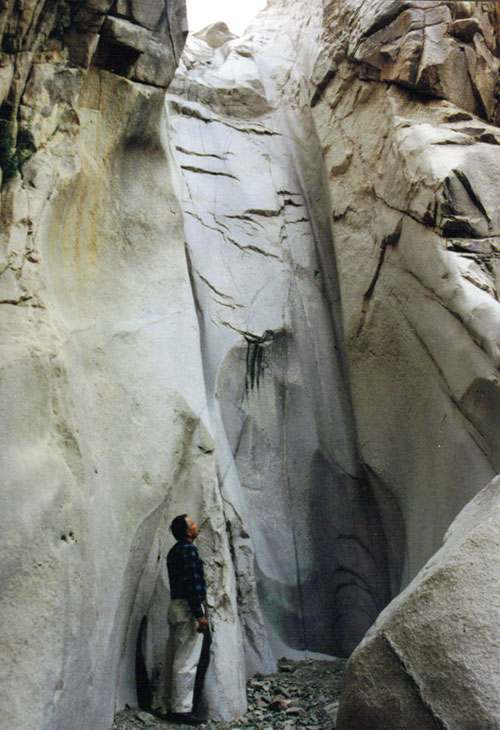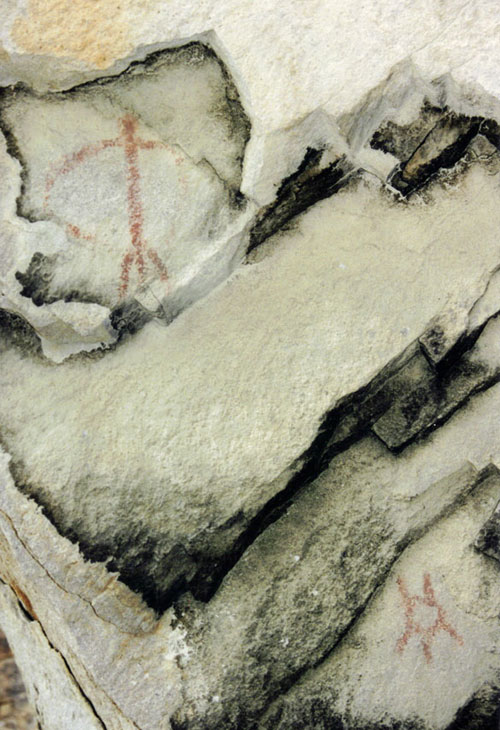South Nevada rock art, part 1
I’m thrilled to introduce Loretta as a guest contributor who will be most generously sharing her observations and amazing photos of rock art that she has found in her home region in southwest US. Loretta has done all the hard work for this short series we are doing so please welcome her with your comments. Now in Loretta’s own words….
Greetings from the Mojave Desert in southern Nevada. When I discovered Marja-Leena’s blog, I felt a kinship due to her interest in ancient rock art and a shared Finnish heritage. All of my grandparents immigrated from Finland prior to World War I, arriving in Upper Michigan. I had the good fortune to visit Finland, in 2001 and 2007, with my sister. We discovered long-lost cousins who greeted us with warmth and gracious hospitality. While there, I became aware of the images that the Sami people in the far North of Finland – still known as Lapland to most of the world – use to decorate their drumheads and other objects. The images reminded me of the Native American pictographs and petroglyphs found in the West.
Reading Marja-Leena’s blog and seeing her petroglyph photos sent me searching through my photos (pre-digital!). I wrote to Marja-Leena and offered to send her some of my photographs of petroglyphs and pictographs found in southern Nevada to compare. She graciously offered to allow me to share them via her blog.

Petroglyphs and rock paintings (pictographs) appear in many locations around southern Nevada, most often near water. Although the origins and meanings of the markings are under discussion, clearly they have been created by ancient people recording events in their daily lives.
The two photos here I find most fascinating. My husband and I found this location after reading about it in a local newspaper. It is in a low range of mountains a mile or so off a main highway running across a wide valley containing a dry lake bed. Although seldom seen in the desert, water leaves evidence of its existence all around – dry lakes, streams, and rivers abound. Running water carved the rock formation pictured over eons, yet there is not a visible water source above it. It is at the end of a short slot canyon that opens out onto an alluvial fan sloping down across a busy highway to the dry lake bed.

As we turned our backs on the highway and entered the canyon, the sound of silence enveloped us. I walked under a low hanging rock ledge along the canyon and happened to look up to see two faint paintings on the ceiling above me – a figure with encircling arms and a sun, perhaps? They are not visible to anyone unless you walk under the ledge and look up. They reminded me of the first rock painting that I remember seeing – a red hand print on the wall of a cliff, high above a trail in Montana at the confluence of the North and South Forks of the Sun River. My good fortune is to have seen these reminders of those who have gone before me.
All photographs © Loretta
Further reading: Nevada Rock Art Foundation
and the rest of the series:
South Nevada rock art, part 2
South Nevada rock art, part 3
South Nevada rock art, part 4
May 2, 2010 in Culture, Rock Art & Archaeology by Marja-Leena
Welcome Loretta! And thank you Marja-Leena! I look forward to more photos. The Sami have long held a fascination for me. I’m intrigued that the glyphs appear near water … I wonder why.
I’m happy to meet you Loretta and look forward to seeing more of your glyph photographs. Knowing of the people who inhabited North America for thousands of years in harmony with nature leaves me wistful.
Thank you for your warm welcome! In the desert, water is life. Artesian springs – water that bubbled up out of the ground naturally – were found throughout the desert, providing a gathering place for the inhabitants. Over the past 50 years, many of the springs have dried up, due to modern demands. So, what remains is the illusion of water, and the ancient “graffiti” carved into the rocks – could they have been bored teenagers? – for us to puzzle over.
You and Loretta may see it as an art form but I am cast back forty-five years and see it as a rock climber’s playground. Too tough for me, though. As a poor practitioner I scrutinised faces for “jugs” (ie, jug handles, handholds that provided a good sense of security) and I don’t see too many here. But others – often wearing Lycra and with a small bag of chalk dust attached to their belt – would do the honourable thing.
Loretta, thanks so much for your response to the comments, on top of your great photos and words! I’m so excited by our collaboration.
BB, rock climbing is extremely popular around here, mostly with the young and strong, and there are many popular spots for this sport. I would hope and expect of course that they respect and stay off any rock faces that have petroglyphs or pictographs on them. Even taking rubbings of them wears them down and vandalism is a serious problem. Sorry, end of lecture!
Do you know what was used to make the reddish pictographs? I know that everything is preserved better in that dry desert air, but it is still amazing to think that these drawings have survived.
Loretta, I read this piece thinking how FORTUNATE you are that you and your husband can share these interests together.
Loretta might answer this one though I believe the early artists used mixtures of red ochre, grease, sometimes blood. Usually pictographs don’t survive the elements as well as petroglyphs do, so it really says something about the dry climate that these are so dramatic still. These ones are also protected by the rock overhang.
Bee: ML has it just right – but the most important aspect was the location, well-protected on the “ceiling” of an overhanging ledge. Someone chose that location very carefully, so the symbols perhaps had a special meaning to the person who placed them there.
And yes, thank you, I am fortunate!